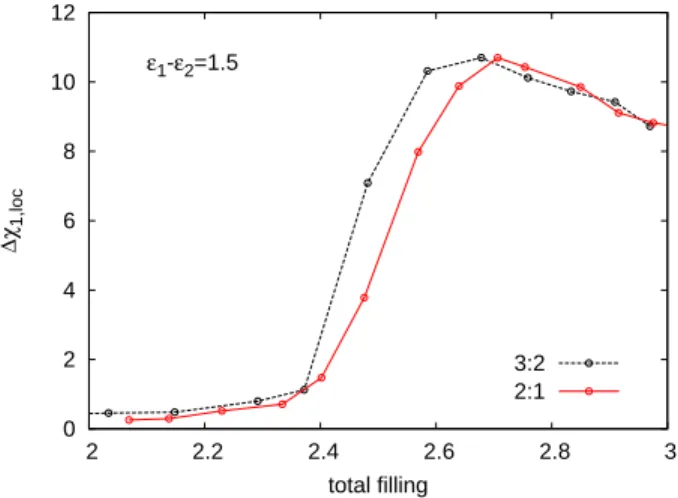Nickelate superconductors – Multiorbital nature and spin freezing
Supplementary Material
Philipp Werner1
and Shintaro Hoshino2
1
Department of Physics, University of Fribourg, 1700 Fribourg, Switzerland
2
Department of Physics, Saitama University, Saitama 338-8570, Japan
In the main text, we considered a two-orbital system with a bandwidth ratio of 3:2 between the higher-lying and lower-lying orbital. Here, we provide additional data for a bandwidth ratio of 2:1, fixing the crystal field split-ting to ǫ1− ǫ2= 1.5.
Figure 1 shows the single-site DMFT results for the orbital occupation, analogous to the left panel of Fig. 1 in the main text. For the red curves, we chose a band-width of 3 for the dx2−y2 orbital and 1.5 for the lower-lying orbital (representing, e. g., dxy), while the interac-tion parameters U = 2.6, U′ = 1.3, J = 0.5 are as in the main text. The black curves show the results in the main text (bandwidths of 3 and 2, respectively) for com-parison. Near three electron filling, the main difference is that the narrower lower band remains fully occupied up to slightly larger hole dopings. Since the cost of pro-moting an electron from the narrower lower band to the upper band (at fixed ǫ1− ǫ2) is larger, more holes are ini-tially doped into the higher-lying orbital. An even larger difference between the two simulation results is observed below fillings of about 1.5. Here, for the bandwidth ratio of 2:1, the filling of the narrow band is locked at 1. An inspection of the Green’s functions (not shown) reveals
0 0.5 1 1.5 2 1 1.5 2 2.5 3 orbital filling total filling ε1-ε2=1.5 3:2 orbital 1 3:2 orbital 2 2:1 orbital 1 2:1 orbital 2
FIG. 1: Orbital filling versus total filling. Orbital 1 (2) refers to the higer-lying (lower-lying) orbital. Red curves are for bandwidth ratio 2:1 and black curves (from the main text) for bandwidth ratio 3:2. The solid black vertical line indicates the experimental filling of 2.67 electrons, and the dashed black vertical line the filling of self-doped NdNiO2.
that the system is in an orbital-selective Mott state, with a half-filled Mott insulating lower orbital. Hence, in the very large doping region (outside of the region of inter-est for superconductivity), the model with the narrower lower band exhibits orbital-selective Mott behavior.
Figure 2 plots ∆χ1,loc(dynamical contribution to the local spin susceptibility in orbital 1) as a function of to-tal filling. The red line shows the result for bandwidth ratio 2:1 and the black line the result in the main text for bandwidth ratio 3:2. For the red data, we use the band-widths Wf = 2.4, Wc = 4.2 for α = 1 and Wf = 1.2, Wc= 2.1 for α = 2. The qualitative behavior of ∆χ1,loc is the same in the two models, but the suppression of the dynamical spin susceptibility due to spin freezing in the hole-overdoped region is more prominent in the model with narrower lower band. This can be understood as a result of the stronger correlations, which stabilize the spin-frozen state near n = 2. Because the crossover to this spin-frozen state is shifted to smaller hole dopings, also the maximum in ∆χ1,locis shifted to lower hole dop-ings, and the peak value is slightly reduced. We thus expect slightly reduced spin fluctuations (and a reduced pairing tendency) in the optimal doping region.
0 2 4 6 8 10 12 2 2.2 2.4 2.6 2.8 3 ∆χ1,loc total filling ε1-ε2=1.5 3:2 2:1
FIG. 2: Dynamical contribution to the local spin susceptibil-ity in orbital 1 as a function of total filling. A large value of ∆χ1,loc near the experimentally relevant filling of 2.67 is
consistent with d-wave pairing at low temperature. The red data are for bandwidth ratio 2:1 and the black dashed data (from the main text) are for bandwidth ratio 3:2.
